Abstract
The proton pump, a H+/K(+)-ATPase located on the secretory canalicular membrane of the parietal cell, forms the final pathway for gastric acid secretion. Omeprazole is concentrated in the secretory canaliculus, where it is converted to its active form, which binds covalently with the H+/K(+)-ATPase, thus inhibiting acid secretion arising from any stimulus. Meta-analysis has defined the primary determinants for peptic ulcer healing as the degree of acid suppression, the duration of suppression over 24 hours, and the length of treatment. The longer duration of acid suppression with omeprazole, particularly during the day, when food is ingested and H2-receptor antagonists are less effective, is reflected in the clinical superiority for symptom relief and ulcer healing and especially for the treatment of erosive esophagitis. Extensive clinical experience has proved omeprazole to be safe, and concerns over hypergastrinemia, ECL-cell hyperplasia, and carcinoid formation have not been substantiated in humans. Recent evidence has shown that omeprazole suppresses Helicobacter pylori and, in combination with antibiotics, can eradicate this organism in a substantial proportion of patients. This effect may result from enhancement of antibiotic bioavailability and optimizing host defense mechanisms.
Full text
PDF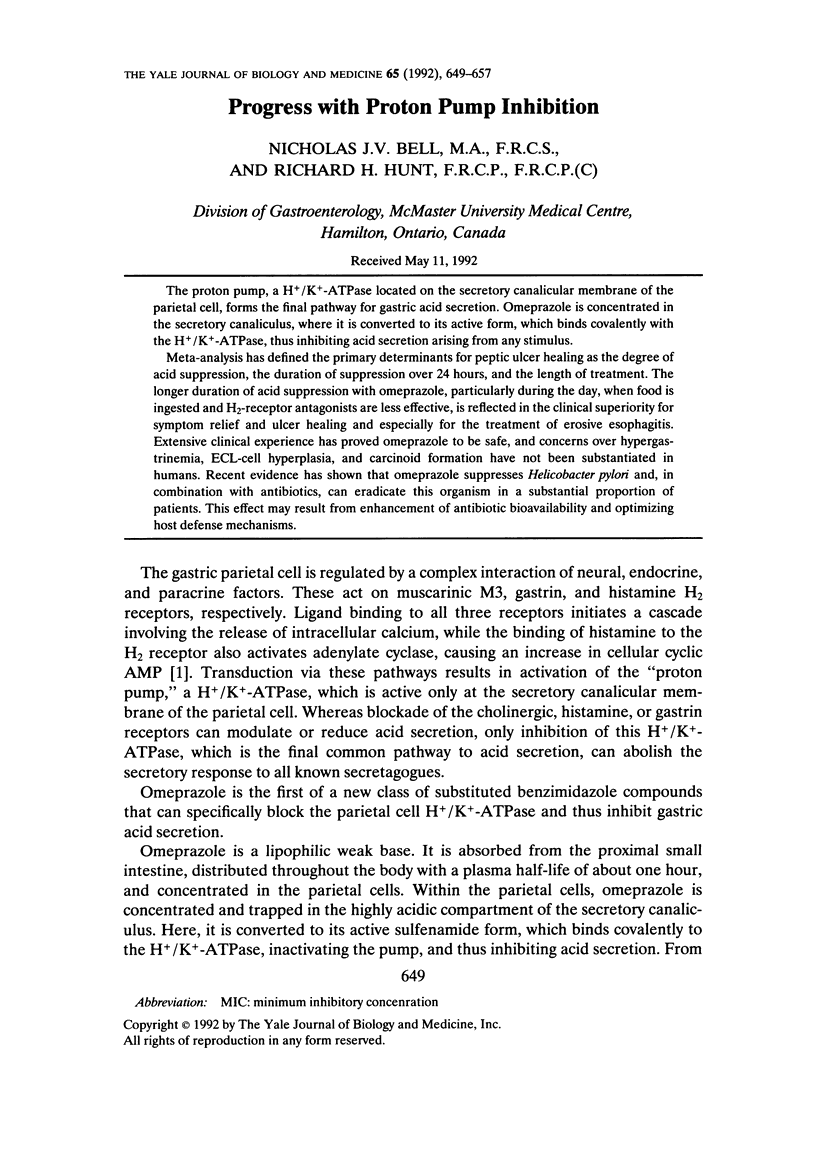
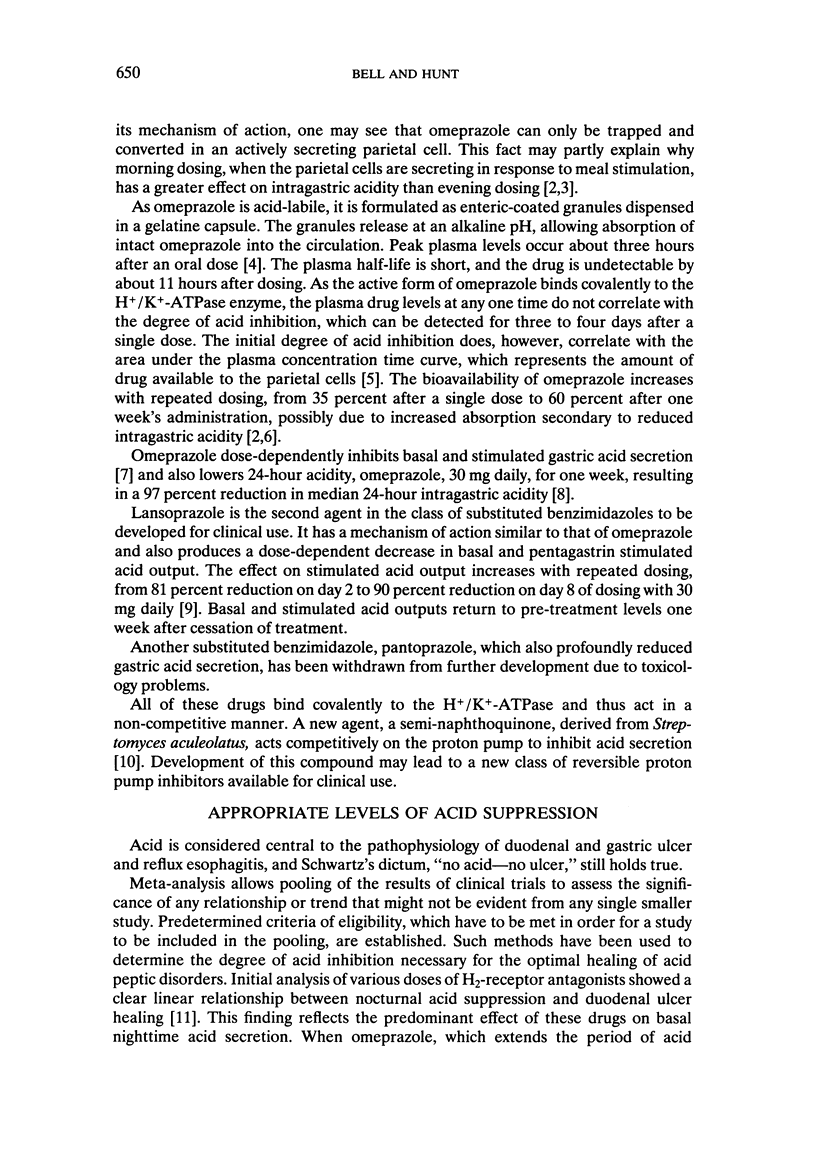
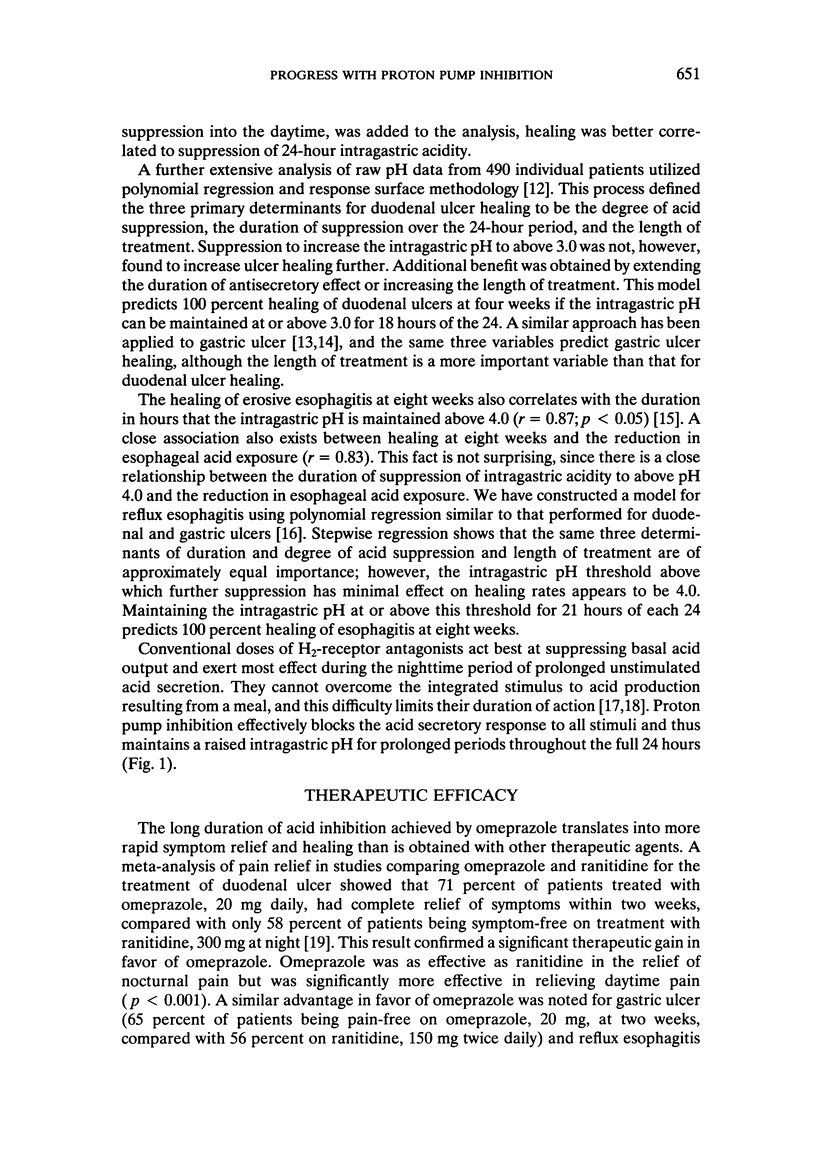
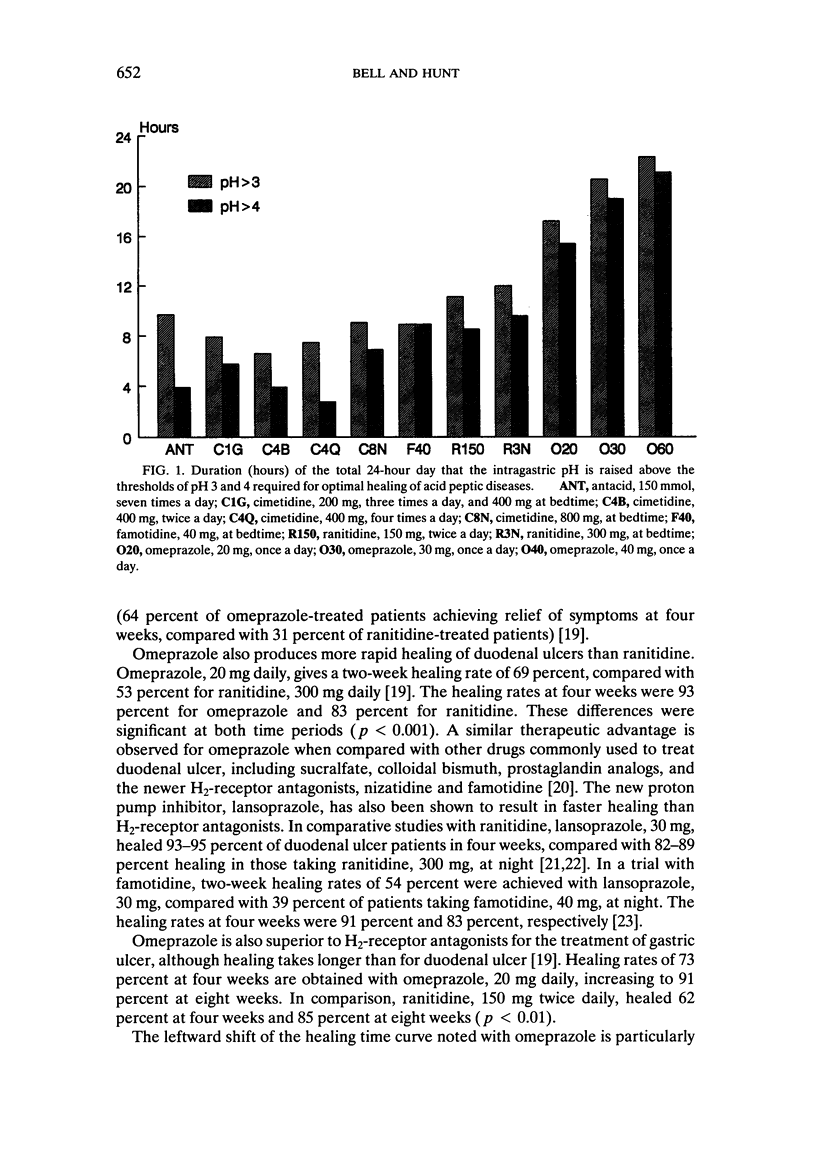
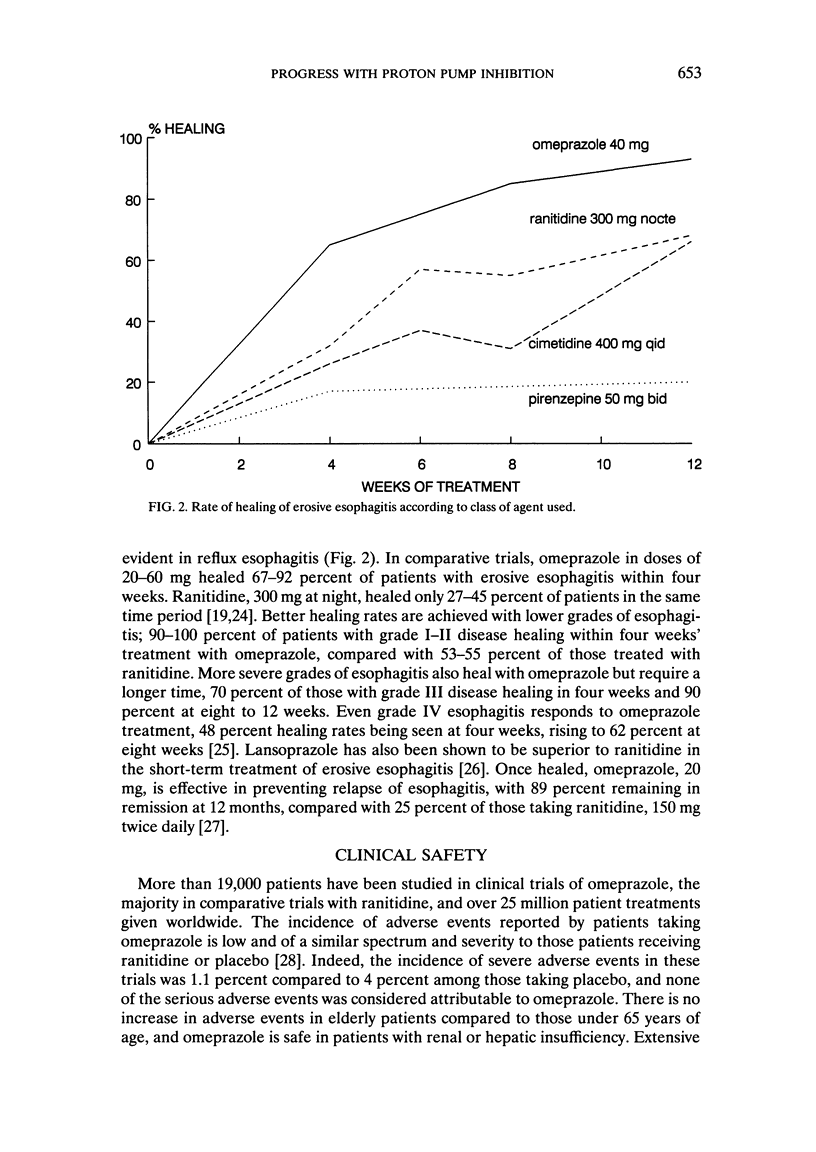
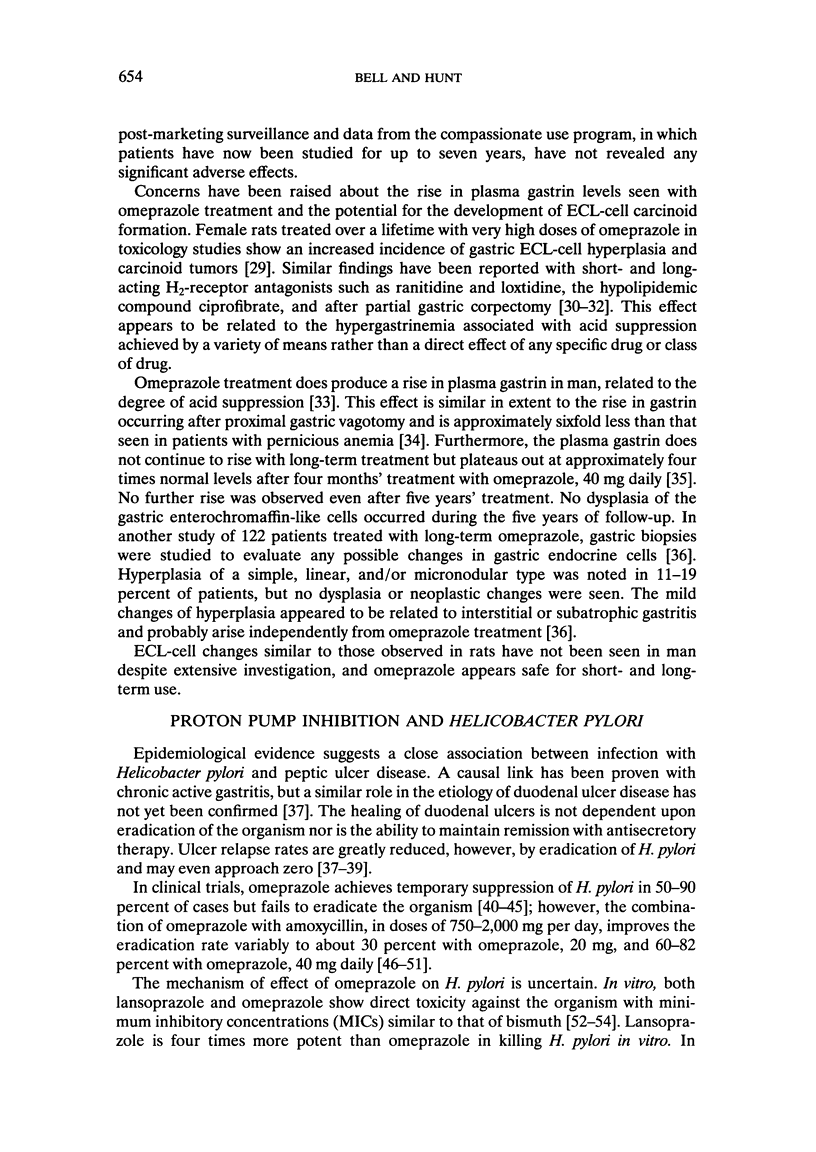
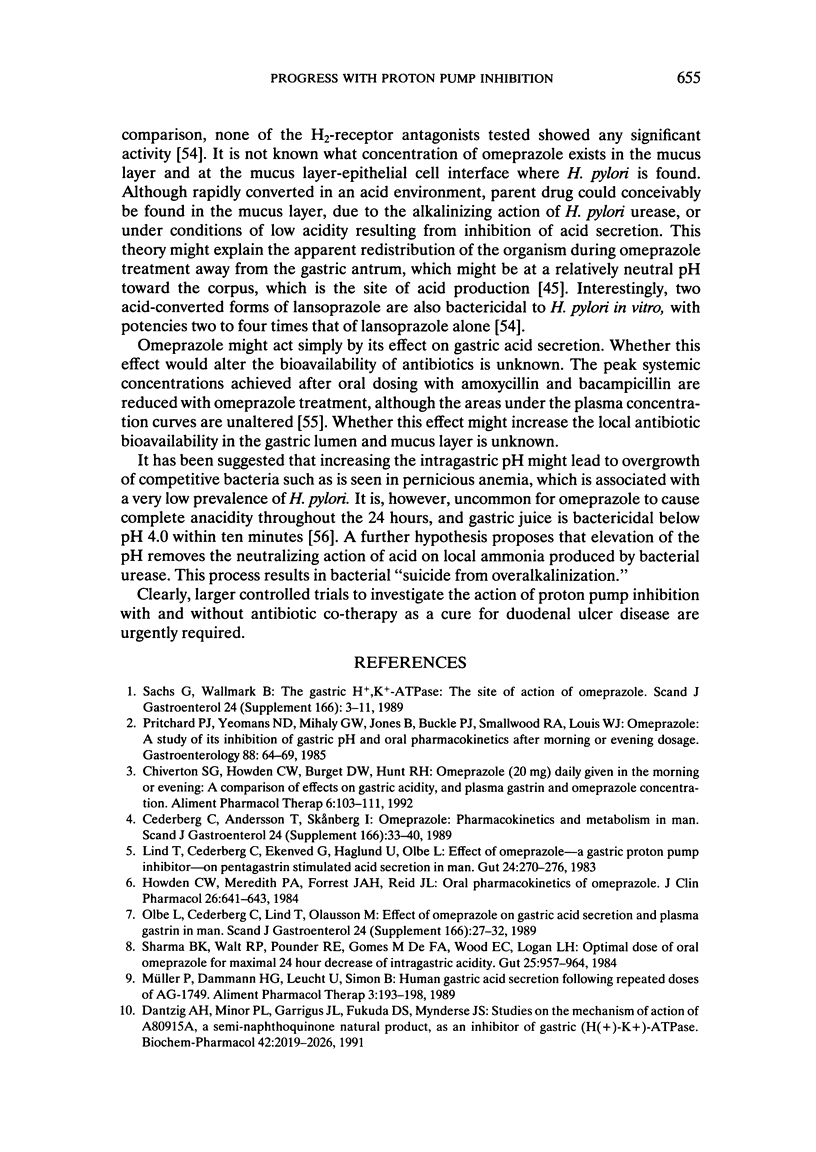
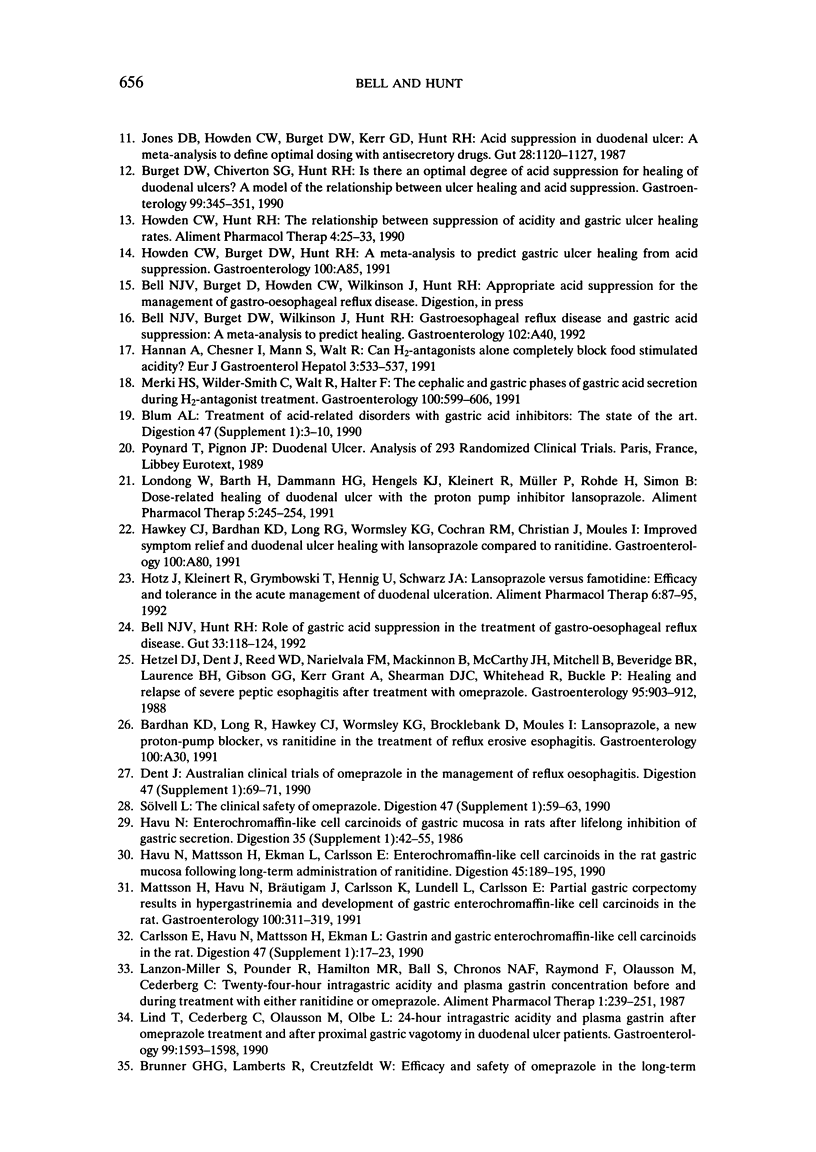
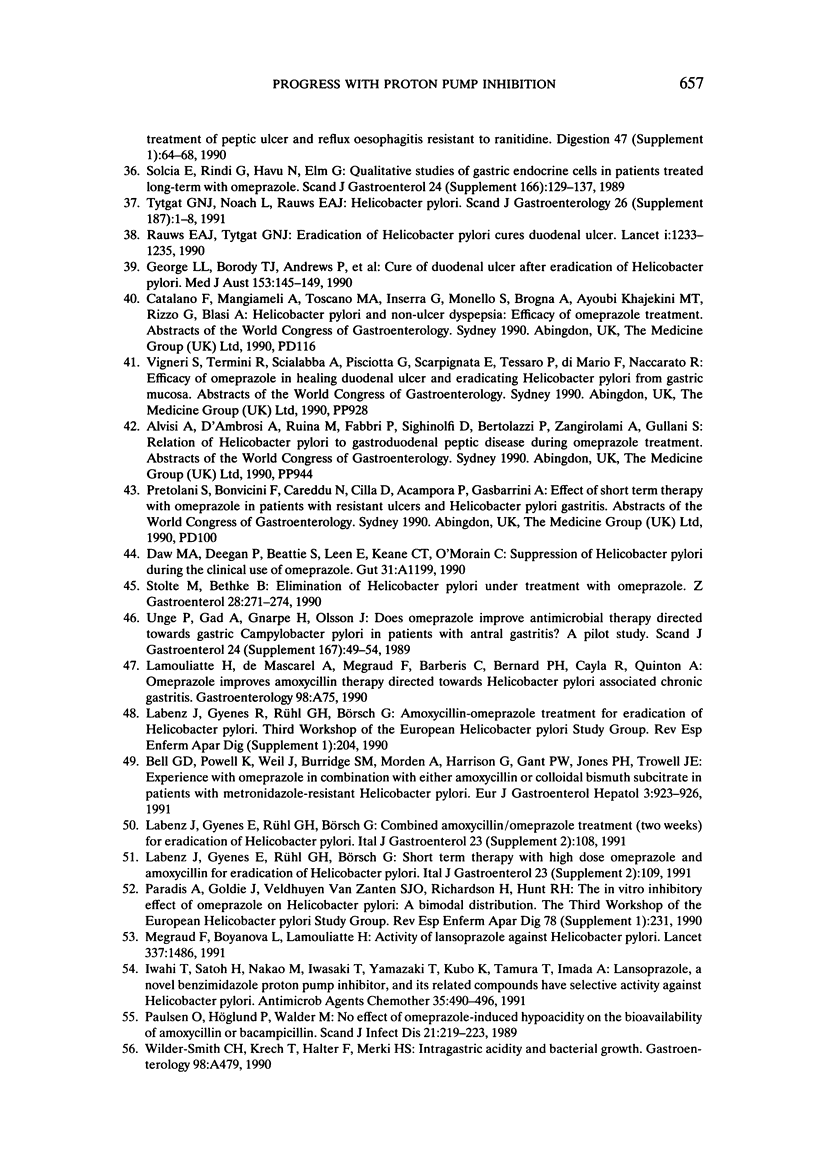
Selected References
These references are in PubMed. This may not be the complete list of references from this article.
- Bell N. J., Hunt R. H. Role of gastric acid suppression in the treatment of gastro-oesophageal reflux disease. Gut. 1992 Jan;33(1):118–124. doi: 10.1136/gut.33.1.118. [DOI] [PMC free article] [PubMed] [Google Scholar]
- Blum A. L. Treatment of acid-related disorders with gastric acid inhibitors: the state of the art. Digestion. 1990;47 (Suppl 1):3–52. doi: 10.1159/000200507. [DOI] [PubMed] [Google Scholar]
- Brunner G. H., Lamberts R., Creutzfeldt W. Efficacy and safety of omeprazole in the long-term treatment of peptic ulcer and reflux oesophagitis resistant to ranitidine. Digestion. 1990;47 (Suppl 1):64–76. doi: 10.1159/000200520. [DOI] [PubMed] [Google Scholar]
- Burget D. W., Chiverton S. G., Hunt R. H. Is there an optimal degree of acid suppression for healing of duodenal ulcers? A model of the relationship between ulcer healing and acid suppression. Gastroenterology. 1990 Aug;99(2):345–351. doi: 10.1016/0016-5085(90)91015-x. [DOI] [PubMed] [Google Scholar]
- Carlsson E., Havu N., Mattsson H., Ekman L. Gastrin and gastric enterochromaffin-like cell carcinoids in the rat. Digestion. 1990;47 (Suppl 1):17–52. doi: 10.1159/000200510. [DOI] [PubMed] [Google Scholar]
- Cederberg C., Andersson T., Skånberg I. Omeprazole: pharmacokinetics and metabolism in man. Scand J Gastroenterol Suppl. 1989;166:33–42. doi: 10.3109/00365528909091241. [DOI] [PubMed] [Google Scholar]
- Chiverton S. G., Howden C. W., Burget D. W., Hunt R. H. Omeprazole (20 mg) daily given in the morning or evening: a comparison of effects on gastric acidity, and plasma gastrin and omeprazole concentration. Aliment Pharmacol Ther. 1992 Feb;6(1):103–111. doi: 10.1111/j.1365-2036.1992.tb00550.x. [DOI] [PubMed] [Google Scholar]
- Dantzig A. H., Minor P. L., Garrigus J. L., Fukuda D. S., Mynderse J. S. Studies on the mechanism of action of A80915A, a semi-naphthoquinone natural product, as an inhibitor of gastric (H(+)-K+)-ATPase. Biochem Pharmacol. 1991 Oct 24;42(10):2019–2026. doi: 10.1016/0006-2952(91)90603-3. [DOI] [PubMed] [Google Scholar]
- Dent J. Australian clinical trials of omeprazole in the management of reflux oesophagitis. Digestion. 1990;47 (Suppl 1):69–71. doi: 10.1159/000200521. [DOI] [PubMed] [Google Scholar]
- George L. L., Borody T. J., Andrews P., Devine M., Moore-Jones D., Walton M., Brandl S. Cure of duodenal ulcer after eradication of Helicobacter pylori. Med J Aust. 1990 Aug 6;153(3):145–149. doi: 10.5694/j.1326-5377.1990.tb136833.x. [DOI] [PubMed] [Google Scholar]
- Havu N. Enterochromaffin-like cell carcinoids of gastric mucosa in rats after life-long inhibition of gastric secretion. Digestion. 1986;35 (Suppl 1):42–55. doi: 10.1159/000199381. [DOI] [PubMed] [Google Scholar]
- Havu N., Mattsson H., Ekman L., Carlsson E. Enterochromaffin-like cell carcinoids in the rat gastric mucosa following long-term administration of ranitidine. Digestion. 1990;45(4):189–195. doi: 10.1159/000200245. [DOI] [PubMed] [Google Scholar]
- Hetzel D. J., Dent J., Reed W. D., Narielvala F. M., Mackinnon M., McCarthy J. H., Mitchell B., Beveridge B. R., Laurence B. H., Gibson G. G. Healing and relapse of severe peptic esophagitis after treatment with omeprazole. Gastroenterology. 1988 Oct;95(4):903–912. doi: 10.1016/0016-5085(88)90162-x. [DOI] [PubMed] [Google Scholar]
- Hotz J., Kleinert R., Grymbowski T., Hennig U., Schwarz J. A. Lansoprazole versus famotidine: efficacy and tolerance in the acute management of duodenal ulceration. Aliment Pharmacol Ther. 1992 Feb;6(1):87–95. doi: 10.1111/j.1365-2036.1992.tb00548.x. [DOI] [PubMed] [Google Scholar]
- Howden C. W., Hunt R. H. The relationship between suppression of acidity and gastric ulcer healing rates. Aliment Pharmacol Ther. 1990 Feb;4(1):25–33. doi: 10.1111/j.1365-2036.1990.tb00445.x. [DOI] [PubMed] [Google Scholar]
- Howden C. W., Meredith P. A., Forrest J. A., Reid J. L. Oral pharmacokinetics of omeprazole. Eur J Clin Pharmacol. 1984;26(5):641–643. doi: 10.1007/BF00543502. [DOI] [PubMed] [Google Scholar]
- Iwahi T., Satoh H., Nakao M., Iwasaki T., Yamazaki T., Kubo K., Tamura T., Imada A. Lansoprazole, a novel benzimidazole proton pump inhibitor, and its related compounds have selective activity against Helicobacter pylori. Antimicrob Agents Chemother. 1991 Mar;35(3):490–496. doi: 10.1128/aac.35.3.490. [DOI] [PMC free article] [PubMed] [Google Scholar]
- Jones D. B., Howden C. W., Burget D. W., Kerr G. D., Hunt R. H. Acid suppression in duodenal ulcer: a meta-analysis to define optimal dosing with antisecretory drugs. Gut. 1987 Sep;28(9):1120–1127. doi: 10.1136/gut.28.9.1120. [DOI] [PMC free article] [PubMed] [Google Scholar]
- Lanzon-Miller S., Pounder R. E., Hamilton M. R., Ball S., Chronos N. A., Raymond F., Olausson M., Cederberg C. Twenty-four-hour intragastric acidity and plasma gastrin concentration before and during treatment with either ranitidine or omeprazole. Aliment Pharmacol Ther. 1987 Jun;1(3):239–251. doi: 10.1111/j.1365-2036.1987.tb00623.x. [DOI] [PubMed] [Google Scholar]
- Lind T., Cederberg C., Ekenved G., Haglund U., Olbe L. Effect of omeprazole--a gastric proton pump inhibitor--on pentagastrin stimulated acid secretion in man. Gut. 1983 Apr;24(4):270–276. doi: 10.1136/gut.24.4.270. [DOI] [PMC free article] [PubMed] [Google Scholar]
- Lind T., Cederberg C., Olausson M., Olbe L. 24-hour intragastric acidity and plasma gastrin after omeprazole treatment and after proximal gastric vagotomy in duodenal ulcer patients. Gastroenterology. 1990 Dec;99(6):1593–1598. doi: 10.1016/0016-5085(90)90462-a. [DOI] [PubMed] [Google Scholar]
- Londong W., Barth H., Dammann H. G., Hengels K. J., Kleinert R., Müller P., Rohde H., Simon B. Dose-related healing of duodenal ulcer with the proton pump inhibitor lansoprazole. Aliment Pharmacol Ther. 1991 Jun;5(3):245–254. doi: 10.1111/j.1365-2036.1991.tb00025.x. [DOI] [PubMed] [Google Scholar]
- Mattsson H., Havu N., Bräutigam J., Carlsson K., Lundell L., Carlsson E. Partial gastric corpectomy results in hypergastrinemia and development of gastric enterochromaffinlike-cell carcinoids in the rat. Gastroenterology. 1991 Feb;100(2):311–319. doi: 10.1016/0016-5085(91)90197-s. [DOI] [PubMed] [Google Scholar]
- Megraud F., Boyanova L., Lamouliatte H. Activity of lansoprazole against Helicobacter pylori. Lancet. 1991 Jun 15;337(8755):1486–1486. doi: 10.1016/0140-6736(91)93181-8. [DOI] [PubMed] [Google Scholar]
- Merki H. S., Wilder-Smith C. H., Walt R. P., Halter F. The cephalic and gastric phases of gastric secretion during H2-antagonist treatment. Gastroenterology. 1991 Sep;101(3):599–606. doi: 10.1016/0016-5085(91)90515-m. [DOI] [PubMed] [Google Scholar]
- Müller P., Dammann H. G., Leucht U., Simon B. Human gastric acid secretion following repeated doses of AG-1749. Aliment Pharmacol Ther. 1989 Apr;3(2):193–198. doi: 10.1111/j.1365-2036.1989.tb00205.x. [DOI] [PubMed] [Google Scholar]
- Olbe L., Cederberg C., Lind T., Olausson M. Effect of omeprazole on gastric acid secretion and plasma gastrin in man. Scand J Gastroenterol Suppl. 1989;166:27–42. doi: 10.3109/00365528909091240. [DOI] [PubMed] [Google Scholar]
- Paulsen O., Höglund P., Walder M. No effect of omeprazole-induced hypoacidity on the bioavailability of amoxycillin or bacampicillin. Scand J Infect Dis. 1989;21(2):219–223. doi: 10.3109/00365548909039972. [DOI] [PubMed] [Google Scholar]
- Prichard P. J., Yeomans N. D., Mihaly G. W., Jones D. B., Buckle P. J., Smallwood R. A., Louis W. J. Omeprazole: a study of its inhibition of gastric pH and oral pharmacokinetics after morning or evening dosage. Gastroenterology. 1985 Jan;88(1 Pt 1):64–69. doi: 10.1016/s0016-5085(85)80133-5. [DOI] [PubMed] [Google Scholar]
- Rauws E. A., Tytgat G. N. Cure of duodenal ulcer associated with eradication of Helicobacter pylori. Lancet. 1990 May 26;335(8700):1233–1235. doi: 10.1016/0140-6736(90)91301-p. [DOI] [PubMed] [Google Scholar]
- Sachs G., Wallmark B. The gastric H+,K+-ATPase: the site of action of omeprazole. Scand J Gastroenterol Suppl. 1989;166:3–11. [PubMed] [Google Scholar]
- Sharma B. K., Walt R. P., Pounder R. E., Gomes M. D., Wood E. C., Logan L. H. Optimal dose of oral omeprazole for maximal 24 hour decrease of intragastric acidity. Gut. 1984 Sep;25(9):957–964. doi: 10.1136/gut.25.9.957. [DOI] [PMC free article] [PubMed] [Google Scholar]
- Solcia E., Rindi G., Havu N., Elm G. Qualitative studies of gastric endocrine cells in patients treated long-term with omeprazole. Scand J Gastroenterol Suppl. 1989;166:129–139. doi: 10.3109/00365528909091260. [DOI] [PubMed] [Google Scholar]
- Stolte M., Bethke B. Elimination of Helicobacter pylori under treatment with omeprazole. Z Gastroenterol. 1990 Jun;28(6):271–274. [PubMed] [Google Scholar]
- Sölvell L. The clinical safety of omeprazole. Digestion. 1990;47 (Suppl 1):59–76. doi: 10.1159/000200519. [DOI] [PubMed] [Google Scholar]
- Tytgat G. N., Noach L., Rauws E. A. Helicobacter pylori. Scand J Gastroenterol Suppl. 1991;187:1–8. doi: 10.3109/00365529109098219. [DOI] [PubMed] [Google Scholar]
- Unge P., Gad A., Gnarpe H., Olsson J. Does omeprazole improve antimicrobial therapy directed towards gastric Campylobacter pylori in patients with antral gastritis? A pilot study. Scand J Gastroenterol Suppl. 1989;167:49–54. doi: 10.3109/00365528909091311. [DOI] [PubMed] [Google Scholar]


